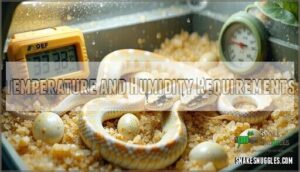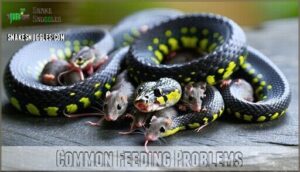This site is supported by our readers. We may earn a commission, at no cost to you, if you purchase through links.
 Looking for a milk snake care sheet PDF? Milk snakes are stunning, low-maintenance pets, but they thrive with proper care.
Looking for a milk snake care sheet PDF? Milk snakes are stunning, low-maintenance pets, but they thrive with proper care.
Start with a secure terrarium; a 20-gallon tank works for adults. Use aspen bedding and provide hiding spots for their shy nature.
Keep temperatures between 75-85°F with a basking area and maintain humidity around 40-60%.
Feed them appropriately sized rodents once a week, and always provide fresh water. Handle gently—they’re non-venomous and generally docile, but patience is key.
Regular health checks and clean habitats prevent issues. Ready to dive deeper? Explore full care tips designed to raise a healthy, happy snake!
Table Of Contents
- Key Takeaways
- Milk Snake Overview
- Choosing The Right Milk Snake
- Milk Snake Housing and Environment
- Milk Snake Feeding and Nutrition
- Milk Snake Health and Hygiene
- Milk Snake Handling and Safety
- Milk Snake Care and Maintenance
- Milk Snake Cost and Budgeting
- Milk Snake Breeding and Reproduction
- Advanced Milk Snake Care and Research
- Frequently Asked Questions (FAQs)
- How do I care for a milksnake?
- How do you care for a milk snake?
- What is the reptifiles milksnake care sheet?
- How do you look after a milk snake?
- How do you feed a milk snake?
- How do you keep a milk snake as a pet?
- What makes a milk snake hard to take care of?
- How to care for a Nelson’s milk snake?
- How do you handle a milk snake?
- How do milksnakes communicate with each other?
- Conclusion
Key Takeaways
- Keep the tank secure and maintain temperatures between 75-85°F with 40-60% humidity to create a comfortable habitat.
- Feed appropriately sized frozen-thawed rodents weekly and always offer fresh water.
- Handle them gently, supporting their body, and limit sessions to avoid stress and build trust.
- Regularly clean the enclosure, monitor for health issues, and provide hiding spots to support their wellbeing.
Milk Snake Overview
Milk snakes are non-venomous reptiles known for their vibrant colors, slender bodies, and unique patterns.
Brightly patterned and non-venomous, milk snakes captivate with their beauty, adaptability, and fascinating mimicry of venomous species.
Native to the Americas, these adaptable snakes thrive in a wide range of habitats and can live up to 20 years with proper care, making them a long-lived species with proper care.
Scientific Classification
Milk snakes, scientifically known as Lampropeltis triangulum, offer fascinating insights into snake species.
Understanding their classification as non-venomous snakes with coral snake mimicry helps you grasp their care needs.
Here’s what you should know:
- They belong to the Colubridae family, known for non-venomous snake subspecies.
- As part of the king snakes, they display incredible subspecies diversity.
- Their taxonomic history and mimicry evolution highlight their role in conservation genetics and phylogeography studies.
Physical Characteristics
Few reptiles can rival the beauty of these snakes with their scale patterns, vibrant colors, and striking subspecies variation.
From the mimicry defense of venomous species to diverse milk snake morphs, they captivate admirers.
A symphony of mimicry and mesmerizing morphs, milk snakes enchant enthusiasts with nature’s artistry and vibrant diversity.
Some stand just 14 inches, while others reach an impressive 6 feet!
This remarkable snake length spectrum offers a glimpse into the fascinating milk snake species and their endless size differences.
Habitat and Distribution
Lampropeltis triangulum’s geographic range spans from Canada to Central America, showcasing its adaptability to various environments.
This snake habitat includes forests, rocky terrains, and prairies, each benefiting its secretive habits.
Here’s how it thrives:
- Forests/Woodlands: Dense cover fits their shy nature.
- Rocky Hillsides: Sun-soaking spots suit their biology.
- Swamps/Wetlands: Damp hideouts enhance survival.
- Farmlands/Prairies: Shelter and prey abound here.
Interestingly, subspecies habitats align with mimicry regions, ensuring survival in diverse snake habitats.
Lifespan and Size
The snake lifespan of milk snakes averages around 20 years, making them a long-term commitment.
With size variation ranging from 14 to 72 inches, their growth rate depends on subspecies size, diet, and care.
Proper planning for their housing is essential, as snake length can increase rapidly.
Factors affecting their lifespan include environment, nutrition, and overall care quality, ensuring a thriving milk snake.
Choosing The Right Milk Snake
Choosing the right milk snake is essential for a successful pet-keeping experience, so focus on picking a species or morph that suits your lifestyle.
Look for signs of good health, like bright, clear eyes and smooth, unblemished scales, to guarantee you start off with a strong and thriving animal.
Milk Snake Temperament and Handling
Handling milk snakes isn’t tricky if you understand their personality and behavior.
They’re gentle but can get stressed. Watch for stress signs like rapid breathing and wriggling. Handle them 2-3 times weekly to build trust and confidence.
- Support their entire body to avoid escape
- Keep hands clean and odor-free
- Limit handling frequency for child safety
- Stay calm to reduce bite risk
Choosing a Healthy Milk Snake
Choosing a healthy milk snake doesn’t have to be tricky. Look for clear eyes, smooth scales, and a natural activity level. Inspect breathing sounds—wheezing isn’t normal.
Always buy from a reputable breeder to avoid pesky health issues. Quarantining prevents surprises like parasites.
Below’s a quick guide:
| Feature | What to Look For |
|---|---|
| Morph Appearance | Vibrant, defined colors |
| Scale Condition | Smooth, unbroken surfaces |
| Breathing Signs | Silent, effortless breathing |
| Activity Level | Alert, curious behavior |
| Seller Type | Trusted, experienced breeder |
Milk Snake Housing and Environment
Creating the perfect home for your milk snake is essential for its well-being and overall health.
You’ll need to focus on providing the right terrarium size, secure enclosure, and proper temperature and humidity conditions to replicate its natural environment, which is crucial for its health.
Terrarium Size and Type
Finding the right milk snake enclosure size is key to keeping your pet comfortable.
A 20-gallon terrarium works well for adults but consider upgrading for larger breeds.
Focus on enclosure materials that guarantee durability and secure locking mechanisms.
Explore custom builds to maximize space and aesthetics.
For the perfect snake enclosure setup, remember:
- Include vertical space for enrichment.
- Prioritize tank security to prevent escapes.
- Try bioactive setups for a natural environment.
Substrate and Decorations
After picking the right terrarium, focus on the substrate and snake decor.
Try aspen shavings for a burrow-friendly snake enclosure substrate. Add sturdy hiding spots, climbing branches, and fake plants for exploration. Include a reliable water dish for comfort.
Many options are available when considering snake bedding materials.
Temperature and Humidity Requirements
How do you create the ideal milk snake habitat? Start with a thermal gradient: basking spots at 85-90°F, a cool side at 75-80°F, and a nighttime drop to 70-75°F.
Keep humidity levels steady at 40-60% using a misting schedule. Many keepers find it useful to buy a hygrometer for accurate readings.
Monitor with a digital probe hygrometer for precision. Seasonal adjustments support your milk snake’s health year-round, promoting comfort.
Lighting and UVB Needs
Proper UVB lighting is part of meeting your milk snake’s lighting needs.
Without it, they can’t benefit from UVB’s role in vitamin D3 production, which helps prevent metabolic bone disease.
Use a bulb like the Zoo Med T5 HO Reptisun 5.0, keeping it about 9-12 inches above the basking area.
Maintain seasonal light cycles—brighter days in summer, shorter ones in winter.
Skip snake enclosure lighting at night or use low-light options.
A solid heat gradient guarantees warmth, so combine UVB benefits with thoughtful snake lighting.
Milk Snake Feeding and Nutrition
Feeding your milk snake properly is essential for its health and well-being, and it starts with understanding its dietary needs.
By choosing the right prey size, feeding schedule, and occasional supplements, you’ll guarantee your snake thrives in captivity.
Diet and Prey Selection
A balanced milk snake diet starts with choosing prey that’s no larger than 1.5 times your snake’s width.
Stick to frozen-thawed prey, like mice, for safety and convenience—live prey can be risky.
Occasionally dust their meals with nutritional supplements to support health.
While their wild diet includes small mammals and birds, captivity calls for controlled feeding.
Reliable prey options, such as frozen-thawed products, are easy to find online.
You can easily find frozen reptile feeders online for your snake.
By following these tips, you’ll guarantee safe and healthy snake feeding practices!
Feeding Frequency and Schedule
Now that you know what to feed your milk snake, establishing the right feeding frequency is your next step.
Feeding schedules vary based on your snake’s age:
- Hatchlings (under 6 months): Offer frozenthawed prey every 5-7 days
- Juveniles (6-18 months): Feed every 7-10 days
- Adults (over 18 months): Feed every 10-14 days
- Larger/older adults: May only need meals every 14 days
Remember the prey size rule—never exceed 1.5 times your snake’s widest body section. After feeding, provide a 48-hour digestion period before handling.
If your milk snake refuses food, check your temperature settings and try feeding at dusk when they’re naturally more active.
Supplements and Vitamins
While your milk snake thrives on a consistent feeding routine, adding the right supplements enhances their overall health.
| Supplement Type | Frequency | Benefits | Signs of Deficiency |
|---|---|---|---|
| Calcium with D3 | Every 3-4 feedings | Bone strength | Tremors, soft jaw |
| Multivitamins | Monthly | Immune support | Lethargy, poor shedding |
| Liquid vitamins | Bi-monthly | Shedding aid | Stuck shed, dullness |
| Repashy CalciumPlus | Every other feeding | Complete nutrition | Poor growth |
Remember, light dusting is sufficient—overdoing supplements can harm your snake, and it’s crucial to avoid poor growth and ensure complete nutrition for your milk snake’s health.
Common Feeding Problems
Even dedicated milk snakes experience common feeding problems.
Monitor your snake when these issues arise:
- Prey refusal often signals stress or improper temperature conditions
- Regurgitation causes include handling too soon after meals or prey too large
- Obesity prevention requires consistent feeding schedules while constipation relief may need soaking
Using frozen-thawed rodents minimizes impaction risks.
Most feeding issues resolve with patience and proper husbandry, preventing nutritional deficiencies in your scaly companion.
Milk Snake Health and Hygiene
You’ll need to monitor your milk snake for common health issues including respiratory infections, mites, and shedding problems to guarantee a long, healthy life.
Regular enclosure cleaning and proper humidity management will prevent most health concerns, making your maintenance routine as important as your feeding schedule.
Common Health Issues and Symptoms
While maintaining proper nutrition is vital, watching for health issues in your milk snake is equally important.
Common problems include respiratory infections, dysecdysis (stuck shed), and parasitic infestations.
Monitor for these warning signs:
- Labored breathing or wheezing
- Mucus around the mouth or nostrils
- Mouth gaping or inability to close properly
- Poor scale condition or glassed-over eyes
- Incomplete shedding, especially retained eye caps
- Unusual bumps, blisters, or missing scales
- Abnormal defecation patterns (constipation)
Your milk snake may show distress through refusal to eat or vomiting after meals. Regular health checks can catch these issues early.
Maintaining proper temperature gradients (75-85°F) and humidity levels (40-60%) prevents many common ailments. If you notice any concerning symptoms, don’t wait—consult an exotic veterinarian experienced with reptiles immediately.
Mites and Ticks Prevention and Treatment
I’ll write an improved version of the mites and ticks prevention and treatment content for your milk snake care article.
Detecting parasites early is essential for your milk snake’s health. After treating common illnesses, watch for these external pests too.
- Identifying mites: Look for tiny black dots moving near eyes, heat pits, and between scales
- Preventing infestations: Quarantine new snakes for 30 days before introducing them
- Safe treatments: Use predatory mites or specialized reptile-safe sprays
- Veterinary options: Consult exotic vets for prescription treatments when home remedies fail
- Quarantine protocols: Isolate affected snakes and thoroughly disinfect all equipment
Regular snake enclosure inspection prevents most parasite problems, saving you and your pet from unnecessary stress.
Respiratory Infections and Shedding Problems
Beyond mites and ticks, respiratory infections and shedding problems represent serious health concerns for milk snakes.
Recognizing symptoms early can prevent complications.
- RI Symptoms: Listen for wheezing, bubbling sounds, or open-mouth breathing
- Shedding Difficulty: Watch for retained eye caps or patches of stuck shed
- Humidity Impact: Maintain 40-60% levels to support healthy respiratory function
- Treatment Options: Provide humid hide boxes with damp moss for shedding issues to aid in healthy shedding
Veterinary Care and Disinfecting
Regular veterinary checkups reveal hidden issues before they become serious problems for your milk snake’s health.
When selecting a herp vet, find one specializing in reptiles. Implement proper sanitation methods by disinfecting the enclosure monthly with reptile-safe cleaners.
Establish quarantine protocols for new snakes to prevent parasite transmission. Practice proper wound management for injuries.
Remember that probiotics benefits include improved digestion and immunity—essential for your snake’s wellbeing, and always consider reptile-safe cleaners.
Milk Snake Handling and Safety
You’ll need to handle your milk snake with confidence and proper technique to guarantee both your safety and the well-being of your pet.
Proper handling reduces stress for your snake while minimizing the risk of escapes or defensive bites, which although rarely dangerous, should still be avoided through consistent, gentle interaction.
Safe Handling Techniques and Precautions
Through proper handling techniques, you’ll build trust with your milk snake while ensuring safety for both of you.
Follow these five steps for safe milk snake handling:
- Approach from the side, not above, to avoid triggering predator responses
- Support the snake’s entire body, never grabbing mid-section
- Limit sessions to 5-10 minutes to prevent stress
- Wash hands before and after handling for sanitary practices
- Recognize stress signals like rapid breathing or hiding face
Children should always be supervised during handling to prevent milk snake bites.
Escaped Milk Snake Prevention and Recovery
Keep your milk snake safe by focusing on Enclosure Security to stop escape risks.
If your escape artist gets out, search for shed skins, warm spaces, or small hiding spots. Move calmly and methodically.
| Prevention Checklist | Recovery Methods | Snake Safety Tips |
|---|---|---|
| Lock enclosure lids | Search warm areas | Avoid sudden moves |
| Seal gaps, escapes | Check dark corners | Handle gently |
| Use secure latches | Look for shed skins | Avoid overcrowding |
| Double-check locks | Ask for help locally | Monitor daily security |
Milk Snake Bites and First Aid
Milk snake bites are rare and generally harmless, posing minimal bite severity or infection risks.
If bitten, stay calm and follow these snake safety steps:
- Wound care: Wash with soap and water to prevent infection.
- Antiseptic use: Apply disinfectant to the area.
- Bandage lightly if needed.
Their snake bites reflect stress, not aggression.
Gentle snake handling tips guarantee your milk snake stays calm and healthy.
Safety Precautions for Children and Pets
Creating a safe environment for kids and pets begins with childproofing enclosures and securing any loose lids.
Though milk snakes are non-venomous, their venomous mimicry could cause fear if misunderstood.
Always prioritize supervised handling to guarantee smooth pet interaction and prevent accidental milk snake bites.
Follow key snake handling tips, like moving gently and avoiding sudden movements.
These safety precautions help reduce stress for your snake while teaching kids important snake care tips about respecting these sensitive, fascinating reptiles.
Milk Snake Care and Maintenance
Proper care and maintenance are essential for your milk snake’s health and well-being.
By keeping their habitat clean, monitoring conditions closely, and scheduling regular health checks, you can help your snake thrive for years to come, ensuring their overall well-being.
Cleaning and Disinfecting The Terrarium
Snake enclosure cleaning is key for keeping your milk snake healthy.
Every few weeks, perform a thorough snake enclosure maintenance with these steps:
- Spot clean daily to handle waste removal.
- Wash and sanitize equipment with reptile-safe disinfectant choices.
- Replace the snake substrate for freshness.
- Scrub the water bowl to guarantee proper hygiene.
- Dry everything completely before reassembling the enclosure.
Preventative measures, like maintaining a clean home, guarantee your milk snake thrives beautifully in their environment.
Regular cleaning also helps in maintaining proper humidity.
Water Quality and Hydration
Water bowl hygiene is key to milk snake care.
Check the snake water dish daily, ensuring hydration monitoring to prevent dehydration signs.
Replace water regularly with fresh, room-temperature water—this doubles as a shedding aid, and use a chlorine remover or safe water supplements to improve quality.
Tracking snake hydration helps spot issues early, and think of the water bowl as your snake’s lifeline; keeping it clean and full makes a world of difference in their health and comfort, as it is crucial for their overall well-being and hydration.
Temperature and Humidity Monitoring
Monitoring your milk snake’s climate is key to keeping them healthy. Use monitoring equipment like infrared thermometers and hygrometers to check their microclimate.
- Keep a thermal gradient: 85-90°F warm side, 70-75°F at night.
- Maintain 40-60% humidity levels.
- Adjust humidity with misting or moist hides.
- Make seasonal adjustments for changing temperature requirements.
It’s your pet’s tropical paradise!
Regular Health Checks and Veterinary Visits
Regular health checks keep your milk snake in top shape.
Start with visual inspections, focusing on skin, eyes, and movement.
Monitor weight and catch subtle changes.
Make certain annual veterinary care, including fecal exams for parasites.
Stay alert for emergency signs like unusual behavior or wheezing.
Preventative care builds a longer, healthier life for your snake—don’t skip it!
Milk Snake Cost and Budgeting
Planning your budget is essential when caring for a milk snake, as expenses go beyond the initial purchase.
Understanding the costs of setup, recurring care, and potential veterinary needs guarantees you’re fully prepared for long-term ownership.
Initial Purchase and Setup Costs
Setting up your milk snake enclosure starts with a terrarium cost for a 10-20 gallon tank.
Next, add heating equipment, substrate expense, decor pricing, and a water bowl.
For initial feeding, grab frozen-thawed prey.
While initial setup costs may feel steep, creating a cozy milk snake setup guarantees your pet thrives in a safe, comfortable, and inviting habitat.
Recurring Costs and Expenses
Recurring costs for milk snake care can quickly add up if you’re unprepared.
Beyond the initial setup costs, you’ll regularly need to budget for food, substrate replacement, and supplement refills. Heating equipment may need occasional replacement too.
Plan ahead with a checklist to avoid surprises:
- Food Costs: Mice or small rats every 10–14 days.
- Substrate Change: Monthly sanitation.
- Heating Maintenance: Annual upgrades.
Budgeting for Veterinary Care and Emergencies
In regards to milk snake care, unexpected veterinary bills can sneak up on you.
Set up an emergency fund for peace of mind, and consider pet insurance to cover costly treatments.
Regular preventative care minimizes health issues.
Compare prices at different clinics, and ask about payment plans or discount clinics specializing in snake veterinary care.
Annual checkups are essential for overall health.
Planning ahead makes certain your snake stays healthy without breaking the bank, ensuring a long and healthy life with proper care and regular checkups.
Cost-Saving Tips and Recommendations
Saving money on milk snake care is easier than you think.
Here are five tips to cut costs without compromising quality:
- Build DIY enclosures using affordable materials.
- Buy bulk food like frozen mice for long-term savings.
- Use affordable heating options like heat mats.
- Shop online or locally for discount supplies.
- Practice preventative care—healthy snakes mean fewer vet bills.
Smart budgeting guarantees happy, healthy pets, and by following these tips, you can ensure quality care for your milk snake.
Milk Snake Breeding and Reproduction
Breeding milk snakes requires careful preparation, proper timing, and attention to environmental conditions to guarantee success.
Understanding their mating behaviors, egg-laying process, and hatchling care will help you achieve healthy offspring.
Breeding and Mating Techniques
Breeding milk snakes pairs the excitement of genetic morphs with snake reproduction.
Before pairing, verify your snakes are healthy and ready. Watch for breeding triggers like tail wrapping and pacing during courtship.
Here’s how to succeed:
- Gradually introduce snakes in a neutral enclosure.
- Maintain ideal temperatures during mating.
- Monitor weights for breeding readiness.
- Prepare for hatchling care before starting.
Egg-Laying and Incubation
Milk snake breeding isn’t complete without proper egg care.
Females lay 6-12 eggs in spring or summer. Keep incubation temperature steady at 82-86°F, with humidity levels around 75%.
Use egg candling to check viability without disturbing. Proper snake incubation guarantees healthier snake hatchlings.
| Clutch Size | Humidity Levels | Incubation Temperature |
|---|---|---|
| 6-12 eggs | Around 75% | 82-86°F |
| Consistent care | Essential for health | Use a thermostat |
| Egg candling | Verifies viability | Guarantees proper hatching |
Hatchling Care and Rearing
Caring for snake hatchlings is exciting but requires attention to detail. Make certain their First Feeding includes small prey weekly and monitor Shedding Issues with proper humidity.
Set up a secure Initial Enclosure to prevent escapes and maintain stable Temperature Gradients for their health. Don’t forget Hatchling Hydration—always provide fresh water.
- Weekly Feedings: Choose prey small enough for easy swallowing.
- Humidity: Essential for smooth shedding.
- Enclosure Security: Prevent wandering juveniles.
- Stable Temperatures: Keep consistent warm gradients.
Genetics and Color Morphs
Understanding genetics opens up a world of possibilities for milk snake enthusiasts.
With selective breeding, you can influence traits like color variations and patterns, creating stunning designer morphs that truly stand out.
Milk snake morphs, such as the vibrant Tangerine Albino Honduran, offer a glimpse into how genetic mutations shape these unique snakes.
Snake morphs inherit traits like albino or hypomelanistic patterns through recessive genetics, much like how certain traits run in families.
Some morphs display bold contrasts, like black outlining around bright red or yellow bands, while others soften into pastel-like blends.
Breeding for these characteristics involves patience and careful pairing to enhance specific traits.
Understanding how dominant genes always express is essential for predicting outcomes.
Imagine crafting a visual masterpiece—a stunning milk snake wearing a kaleidoscope of colors.
Whether you aim for classic patterns or unusual combinations, exploring morph inheritance enriches your experience, helping you appreciate the art and science behind snake genetics.
Advanced Milk Snake Care and Research
Understanding advanced milk snake care helps you provide the best environment and meet their unique needs. Staying informed about current research and techniques guarantees your pet remains healthy and thrives.
Latest Research and Studies on Milk Snakes
Recent milk snake research uncovers exciting insights into their ecology and care. Behavioral studies reveal nocturnal hunting habits and mimicry evolution, while dietary analyses refine nutritional understanding.
Conservation status improvements focus on habitat restoration and reducing fragmentation. Captive breeding boosts genetic diversity, essential for preserving populations.
Investigations into snake health explore immune defenses against diseases, helping owners provide better care. These findings deepen our knowledge of snake behavior and genetic relationships.
Advanced Care Techniques and Recommendations
Ever thought about your milk snake’s winter routine? Brumation improves health and boosts breeding success.
Perfect your care with enrichment strategies like hiding spots and textures to replicate nature. Monitor snake nutrition with advanced supplementation and guarantee proper quarantine protocols for new arrivals to prevent illness.
Ethical snake breeding respects species diversity, including stunning morph mutations. Here’s a guide:
| Technique | Purpose |
|---|---|
| Brumation | Boosts breeding success |
| Enrichment strategies | Stimulates snake behavior |
| Quarantine protocols | Prioritizes snake health |
| Advanced supplementation | Enhances snake nutrition |
| Breeding ethics | Promotes diverse morphs |
Milk Snake Behavior and Body Language
Milk snake behavior tells you a lot about their mood and health.
Defensive postures like tail shaking mean they feel threatened, while hiding or hissing might signal stress.
Watch for shedding signs, as dull skin and reduced activity hint it’s time.
Hunting behavior includes tongue flicking and increased movement, showing they’re ready to eat.
Social interaction among snakes is rare, but nudging during breeding season is one example.
By reading your snake’s body language, you can improve milk snake care and handling easily.
Observing their tongue flicking behavior can also provide insights into their environment.
Conservation Efforts and Threats to Milk Snakes
Milk snakes face challenges that threaten their survival.
Habitat loss and road mortality shrink their range, while invasive species disrupt ecosystems. The illegal trade also harms populations.
Here’s how you can help:
- Minimize pesticide use to protect snake prey.
- Support habitat conservation projects.
- Advocate for green initiatives against climate change.
- Report illegal trade to protect these snakes.
Frequently Asked Questions (FAQs)
How do I care for a milksnake?
Caring for a milksnake means providing a secure enclosure, proper heating (75-90°F), UVB lighting, and humidity (40-60%).
Feed appropriately sized frozen-thawed prey weekly and keep the habitat clean and escape-proof.
How do you care for a milk snake?
Imagine a slithering rainbow with unique needs—milk snakes thrive with a secure enclosure, warm basking spot, cool hideouts, and proper humidity.
Feed appropriately sized rodents weekly, verify UVB lighting, and monitor temperatures carefully.
What is the reptifiles milksnake care sheet?
ReptiFiles’ milk snake care sheet offers expert tips on housing, feeding, and maintaining proper temperatures and humidity.
You’ll find advice on enclosures, feeding schedules, and essential UVB lighting to keep your milk snake thriving.
How do you look after a milk snake?
An ounce of prevention is worth a pound of cure—set up an escape-proof enclosure.
Maintain temperatures and humidity, provide hides, and feed appropriately sized prey every 7-14 days based on age and size.
How do you feed a milk snake?
Feed your milk snake with frozen-thawed mice sized to its widest point.
Hatchlings eat every 5-7 days, adults every 10-14 days.
Always supervise feeding, avoid overfeeding, and let the snake digest before handling.
How do you keep a milk snake as a pet?
Caring for a milk snake is like crafting the perfect recipe—you’ll need the right-sized enclosure, proper heating, UVB lighting, balanced humidity, and a diet of frozen-thawed prey.
Keep them solo, they’re snake-eaters!
What makes a milk snake hard to take care of?
Milk snakes can be tricky because their care demands precision.
Maintaining proper temperature, humidity, and enclosure security is essential.
They’re escape artists, sensitive to stress, and need the right-sized prey, making consistent attention essential.
How to care for a Nelson’s milk snake?
Ever wonder what it takes to keep a Nelson’s milk snake happy?
Keep their enclosure escape-proof, maintain a warm basking spot, offer proper humidity, feed frozen-thawed mice, and provide hiding spots for comfort and safety.
How do you handle a milk snake?
Always support your milk snake gently under its body, letting it move freely through your hands.
Avoid squeezing, and handle them for short, stress-free sessions.
Gradual handling builds trust and keeps the snake calm.
How do milksnakes communicate with each other?
Milk snakes communicate mainly through body language, like defensive posturing or vibrating their tails to deter threats.
They’re mostly solitary, so direct interactions between them are rare, happening mainly during mating or territorial disputes.
Conclusion
It’s ironic how such a vibrant, fascinating creature like the milk snake thrives on such simple, consistent care.
By following this milk snake care sheet PDF, you’ll provide your new pet with the ideal habitat, diet, and handling it needs to flourish.
Remember, patience and attention to detail are your best tools for success.
With the right setup and dedication, you’ll enjoy a healthy, docile companion that brings excitement and natural beauty to your home for years.






















